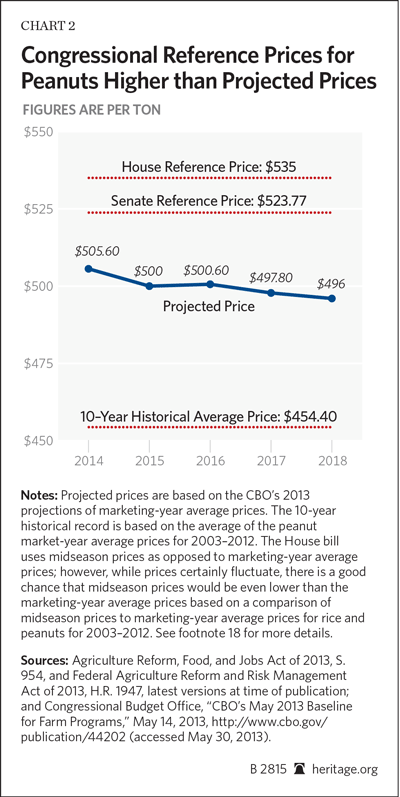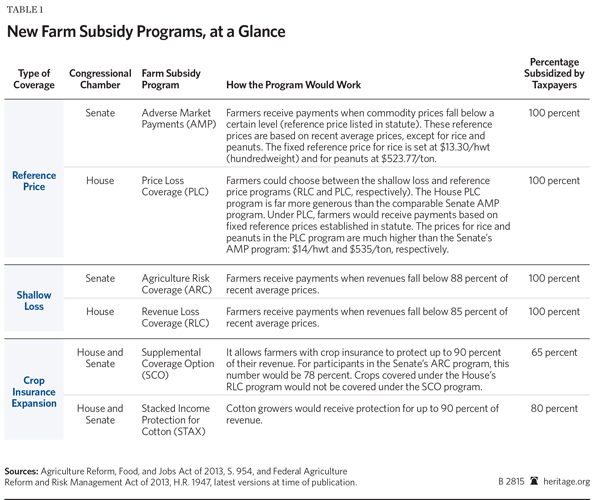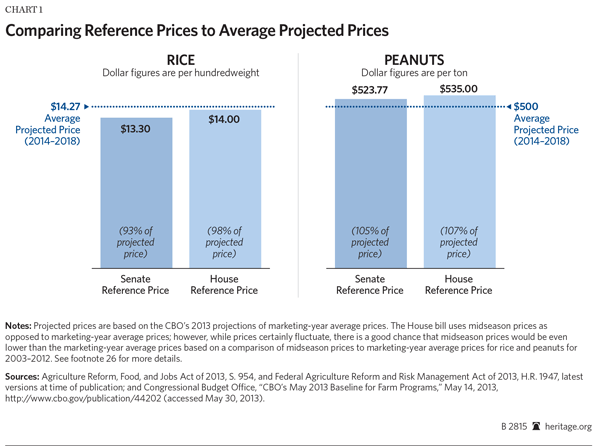The Senate recently passed its farm bill and the House is expected to take up its bill in mid-June.[1] Both farm bills take important steps by eliminating some costly farm subsidy programs, including the direct payment program. However, Congress is playing a shell game. Both bills offset the benefits of eliminating the programs by adding new farm subsidy programs that could prove to be even costlier than the programs they are replacing.
Many of the cost assumptions for the new programs are based on commodity prices staying at or near record highs. If these prices come down to their long-term averages, the costs to taxpayers could be astronomical. Congress is gambling taxpayer money on these risky assumptions. As it is, these new programs make little sense when cutting costs should be a priority. In addition, these programs have little to do with providing safety nets for farmers and everything to do with ensuring that farmers have virtually no risk.
Proposed Programs for Elimination
The House and Senate bills would eliminate the direct payment program, the counter-cyclical program, and the Average Crop Revenue Election (ACRE) program. The direct payment program provides payments to farmers of certain commodities based on past production and fixed payment rates. It is also a program that should have been eliminated years ago and remains a model of government waste. Farmers receive payments regardless of whether they grow anything. From 2003 to 2011, almost 25 percent of total direct payments went to farmers who did not grow the crops for which money was allocated. Even some fallow farms, those farms that did not grow any crops at all on their land, received direct payments.[2]
The counter-cyclical program provides payments to farmers when a commodity price falls below a target price set in statute. The ACRE program was developed as an alternative to the counter-cyclical program, and payments are made when state-level revenue falls below a minimum level and the producer experiences a revenue loss.[3] Yet, the proposed farm bills do not stop with the elimination of these programs—both bills add new programs that could be even costlier.
Crop Insurance Expansion
The costliest farm program is not the direct payment program, but the crop insurance program. The price tag for taxpayers is skyrocketing and needs to be reined in. The average annual cost of the program from 2000 to 2006 was $3.1 billion. This amount more than doubled to $7.6 billion from 2007 to 2012, and is expected to grow to $8.9 billion from 2013 to 2022.[4]
There are bipartisan efforts to reduce these costs, including from President Barack Obama.[5] Yet, both bills would take the irresponsible step of actually increasing the costs of crop insurance. The Senate bill would increase crop insurance costs by $5 billion and the House bill would go even further by increasing the costs by $8.9 billion.[6] There are two new programs in both bills that drive this cost increase: (1) Supplemental Coverage Option (SCO) and (2) Stacked Income Protection for Cotton (STAX).
Supplemental Coverage Option (SCO). This new program would enable farmers who have already purchased crop insurance to add additional coverage that would protect up to 90 percent of their crop revenue.[7] Taxpayers pay 62 percent of the premiums that farmers receive under the current crop insurance program.[8] For the additional SCO coverage, taxpayers would subsidize 65 percent of the premium.[9]
Stacked Income Protection for Cotton (STAX). This program for cotton growers would provide protection for up to 90 percent of their revenue.[10] Taxpayers would pay 80 percent of the premiums.[11]
Shallow Loss: Agriculture Risk Coverage and Revenue Loss Coverage
In addition to the expansion of the crop insurance program, there are major new programs that would be added to cover “shallow” losses. They represent a major shift in how the farm bill operates. The concept of a safety net for farmers who suffer significant losses is being trumped by a new model of protecting farmers from virtually all risk.
All businesses face risks, which serves as a valuable way for them to identify new ways of improving operations and competing more effectively. Taxpayers should not be on the hook for minor losses or to help eliminate competitive challenges that drive innovation in the agricultural sector. The Senate’s Agriculture Risk Coverage (ARC) program and the House’s Revenue Loss Coverage (RLC) program are the primary shallow loss programs in the farm bills that would drastically reduce all risk.
The Senate’s ARC program would make payments to farmers when crop revenue falls below 88 percent of average recent commodity prices. The House’s RLC program works in the same manner but covers crop revenue when it falls below 85 percent of this revenue level.[12] Farmers do not have any “skin in the game” when it comes to these new programs. Taxpayers subsidize all the costs.
These shallow loss programs are not insurance programs, unlike how they are commonly described. They are straight payment programs. Both programs fall under the commodity title, or section, of the farm bill, not the crop insurance title of the bill. There are also no premiums or other components characteristic of an insurance program.

Risk Distortion. When the level of revenue coverage is so high, farmers would feel more emboldened to take risks that they otherwise would not take. After all, they are not paying for this extra coverage that covers even minor losses. Even the American Farm Bureau Federation (AFBF) was recently concerned about shallow loss programs. As the AFBF wrote in an October 17, 2011, letter to the House and Senate Agriculture Committees:
Our biggest concern is that by reducing the risk of shallow losses, farmers may be encouraged to take on more risk than they would in response to market signals alone. This is basically analogous to the classic moral hazard problem of insurance. Insured individuals may engage in riskier behavior than they would if they weren’t insured.[13]
In the same letter, the AFBF also explained why such programs are questionable in value, and effectively acknowledge that a shallow loss program is not a safety net for farmers:
A shallow loss program is a drastic departure from any previous farm policy design. Federal farm programs have traditionally existed to help farmers survive large, systemic losses. Shallow losses, however, can arise from a variety of systemic or individual sources and do not typically jeopardize the survival of a farm operation.[14]
A Gamble on Costs. The Congressional Budget Office (CBO) projects that the Senate’s ARC program would cost $23.7 billion from 2014 to 2023.[15] The bigger problem with the CBO estimate is that it presumes that commodity prices will stay at or near record highs.
Congress is irresponsibly gambling on this assumption. The tax burden on Americans is already high, and the economy is still weak. This is no time to effectively flip a coin and hope that the gamble does not further exacerbate the financial well-being of American families. If the prices decline to more historic levels, taxpayers will be on the hook for much more money. A recent American Enterprise Institute study examining the Senate’s ARC program in the 2012 farm bill, which was similar to what is being proposed this year, found that the program could cost as much as $7 billion annually based on the 15-year historical average price.[16] This is in contrast to the CBO’s projection of an average cost of about $2.9 billion per year from 2013 to 2022.[17]
Reference Price Programs: Adverse Market Payments and Price Loss Coverage
As if the shallow loss programs were not enough, the House and Senate bills also include new income-support programs that would likely provide guaranteed payments to certain farmers. The Senate’s Adverse Market Payment (AMP) program and the House’s Price Loss Coverage (PLC) program are new commodity programs that provide payment.[18] to farmers when commodity prices fall below a certain level (the “reference price” established in the bills).[19]
These payments are allegedly intended to cover deep (major) losses. According to the House Agriculture Committee, regarding its reference price program, “Price Loss Coverage (PLC) is a risk management tool that addresses deep, multiple-year price declines.”[20] This is far from the case, though. If this were true, reference prices would be set well below projected prices so that payments would only be triggered in the event of a major loss.
However, with both bills, the payments are not limited to deep losses. The reference prices for rice and peanuts are set at extremely high levels that would cover shallow losses. (See Chart 1.) In fact, the reference prices for peanuts in both the House and Senate bills are so high that new payments to peanut farmers would be provided right from the start, based on CBO-projected prices. (See Chart 2.)[21] The program is essentially set up to trigger payments for peanut farmers. They would be winning the farm bill lottery at the expense of taxpayers.
The Reference Prices. The Senate bill establishes reference prices for commodities based on recent average prices.[22] Rice and peanuts, though, are given preferential treatment. The Senate bill establishes fixed reference prices in statute for rice ($13.30/hundredweight (hwt)) and peanuts ($523.77/ton). If the formula for setting reference prices for other commodities were applied in the same manner to rice and peanuts, their reference prices would be much lower: rice ($8.03/hwt) and peanuts ($283.43/ton).[23] This amounts to a rice reference price that is 40 percent higher than if the regular commodity reference price formula was used, and a peanut reference price that is 46 percent higher.
While it is hard to imagine, the House bill is even more generous than the Senate bill, and sets fixed reference prices for all the affected commodities. Rice and peanuts would receive even more favorable treatment in the House bill with reference prices of $14/hwt and $535/ton, respectively.[24]
Guaranteed Payments. The average price for rice is projected to be $14.27/hwt from 2014 to 2018.[25] The reference prices for rice are set so high that they would cover even very minor losses.[26] As shown in Chart 1, the projected prices for rice are 98 percent of the House reference price and 93 percent of the Senate reference price. The average price for peanuts is projected to be $500/ton from 2014 to 2018, which means the reference prices are higher than projected.[27] The reference prices for peanuts are set so high that they would result in payments to farmers in each year between 2014 and 2018, based on the CBO’s projections (Chart 2).
There could be payments for other commodities, too, depending on prices. For example, the rice reference price, as with peanuts, could easily be higher than actual prices. In 2012, the CBO projected the price of rice to be $13.19/hwt for the same time period.[28] This would have meant that the rice reference prices in both bills would have been higher than the projected price of rice, thereby triggering payments. Senator Pat Roberts (R–KS) captured the problem with reference or target prices, as explained in a recent article: “‘This [Senate farm bill] is not a reform bill. This is a rearview mirror bill,’ Roberts said. He singled out the target prices set for rice and peanuts as more than equal to the cost of production—‘essentially guaranteeing that a farmer profits if yields are average or above average.’”[29]
Senator Roberts was only speaking about the Senate bill’s reference prices, not the House bill that puts the Senate bill to shame when it comes to spending taxpayer dollars under reference price programs. Both the House and Senate bills would employ the reference price system as a means to eliminate virtually all risk. When reference prices are set so high, Congress is taking a bad gamble at the expense of taxpayers who will pay to make up for lower than expected prices.
No New Programs
While the House and Senate bills do eliminate flawed farm subsidy programs, they replace the programs with numerous new programs that are even worse. There is already more than enough of a safety net for farmers. When the need for cutting government spending is so important, there should be concrete and predictable measures to achieve this objective. These new programs are like a blank check that could stick taxpayers with costs that far exceed current projections.
Congress should not ignore the interests of taxpayers. It should protect their interests by cutting costs as opposed to gambling with taxpayer dollars. The new shallow loss and revenue price programs are costly gambles. If prices do not stay at or near record highs, taxpayers will be the ones paying for this ill-conceived bet.
If Congress truly wanted to help farmers, it would abolish all central-planning policies. This would free farmers from contradictory subsidy programs that tie their hands and limit their ability to use their land as they deem fit. Farmers, consumers, and taxpayers would reap the benefits.
—Daren Bakst is Research Fellow in Agricultural Policy in the Thomas A. Roe Institute for Economic Policy Studies at The Heritage Foundation.




